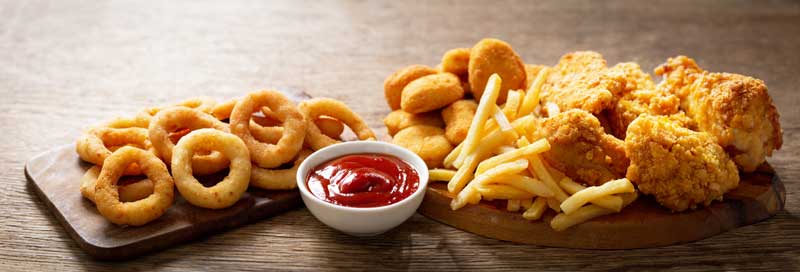In today’s fast-paced world, many of us have been guilty of eating a snack, or possibly, an entire meal, behind the wheel. Over time, there has been an increasing number of distractions behind the wheel that has led to an increase in car accidents. The popularity of drive-through restaurants and coffee shops, especially in Los Angeles, has also led to the commonality of eating behind the wheel. For example, many employees grab a quick bite before sitting in afternoon Los Angeles traffic and heading home. It has become so common that California Highway Patrol has now shifted its focus on distracted driving.
According to the National Highway Traffic Safety Administration (NHTSA), 3,142 lives were lost due to distracted driving in 2019. In a survey conducted by Exxon, more than 70% disclosed that they regularly eat behind the wheel, and 83% disclosed they regularly drink behind the wheel.
Distracted driving is defined by the NHTSA as “talking or texting on the phone, eating or drinking, talking to people in your vehicle, and fiddling with the stereo entertainment or navigation system.” All these actions take your attention off the road and may lead to severe consequences such as injury or death.
Is There a Law That Makes Eating Illegal?
No specific law makes it illegal to eat or drink nonalcoholic beverages behind the wheel. However, there are laws in California that outright ban cell phone usage. It is now illegal to text or call while driving. A police officer could pull over a driver for being on their phone. However, no state has passed a law specifically identifying eating or drinking nonalcoholic beverages as a charge. Unfortunately, driving while eating are not two tasks that could be handled together in a safe manner. For example, if a police officer sees a driver eating behind the wheel, that is not a valid legal reason to initiate a traffic stop or write a traffic ticket. However, the effects of eating behind the wheel have led to negligence and unlawful violations.
Negligence
Eating and driving can lead to serious injury or death. Eating behind the wheel can lead to negligence. Plaintiffs bringing forth a lawsuit would file a claim under negligence. Distracted driving is a form of negligent action. The most common examples of distracted driving include:
- Distracted driving in a school zone
- Distracted driving when there are children in the vehicle
- Speeding
- Going in and out of lanes (most common)
- Running a red light
Oftentimes, the negligent driver will find themselves becoming a defendant in a lawsuit. This then leads to civil liability for the plaintiff’s injuries.
Distractions
Oftentimes, eating a meal would require two hands. For example, unwrapping a sandwich or opening a tight seal container requires two hands. At that point, drivers would then take their hands off the wheel, use their knees to temporarily steer the wheel, or take their eyes off the wheel to clean their hands. This then decreases reaction time, and during this period, the chances of getting into an accident are increased.
Foods to Avoid
NHTSA had released a study that eating or drinking behind the wheel increases the chance of getting into a car accident by 80%. NHTSA had listed the top dangerous foods to avoid. These foods require full attention from the driver behind the wheel and place both the driver and other drivers in peril. The top foods to eat or drink include:
- Coffee: coffee is the most common drink likely to spill. The spill could burn you, and require all your attention when cleaning it up.
- Soup: a hot soup could burn your tongue, and take your attention off the road after the burn.
- Tacos: tacos usually require two hands to eat. The thin shell of a taco is likely to break and fall on the floor of the driver’s side, making it a dangerous distraction when driving.
- Chili dogs: the hot chili has a high risk of spilling all over your lap.
- Hamburgers: other than being messy to eat, hamburgers almost always require two hands, or else it would spill from the other end.
- Chicken wings: wings require two hands, and the greasiness of the food will make you want to clean both your hands after consuming it.
- Donuts: donuts, especially those with powdered sugar, have a tendency of being sticky and needing two hands to consume.
- Soda: if spilled, the spill would take all your attention away from the road because of the sticky mess that would result.
How to Avoid Eating and Driving
The consequences of distracted driving may include injuries or even death. Several studies have compared eating behind the wheel to texting and driving. It is important to practice safe driving skills behind the wheel to prevent any accidents. Below are suggestions by the NHTSA to prevent any eating distractions.
- Try to keep food out of the car. Not only would this decrease the temptation to eat, but it also would keep the interior of your car fresh.
- Plan ahead. If you find yourself eating in the car often, carve out 10-15 minutes to eat before entering your car.
- If you are going to pack food, NHTSA suggests small bite-size snacks such as grapes into easy-to-open containers.
- Steer clear of soda drinks. The fizzing tendency of soda increases the chance of choking or throat irritability.
- Discourage other passengers from also eating. Other passengers eating in your car can tempt you to look back or eat the food yourself.
Other than eating behind the wheel, so many other distractions still may exist, such as texting. Despite being cautious, car accidents unfortunately still occur. If you believe that you or a loved one have become involved in a car accident due to a distracted driver, contact an experienced Los Angeles attorney or Las Vegas attorney at Heidari Law Group today who is experienced in California’s and Nevada’s distracted driving negligence laws. We also have offices in Fresno, Sacramento, and Irvine, California. Heidari Law Group will be there to assist you in every step of the process. Contact an experienced auto accident attorney for a free case evaluation today.
Disclaimer: This blog is created by Heidari Law Group for educational purposes. This article provides a general understanding of the law. It does not provide specific advice. By using this site and reading through this blog, there is no attorney-client relationship created between you and any member of Heidari Law. Further, due to the constant change of the law, some parts of the information above may no longer be good law.




